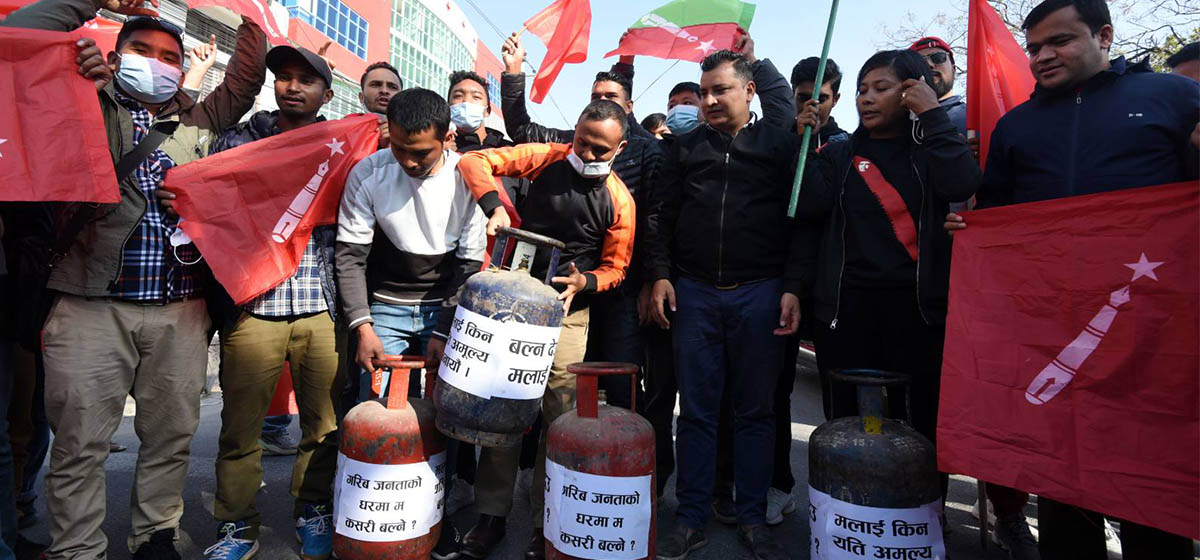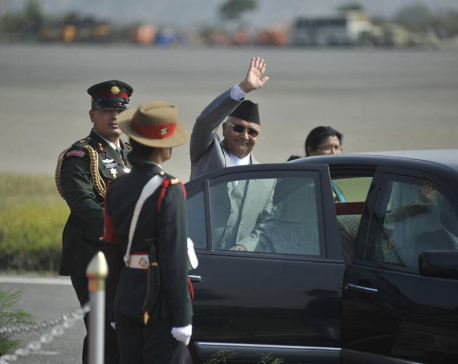
OR
#Opinion
Nepal needs prudent measures as inflation hits global level
Published On: August 23, 2022 05:27 AM NPT By: Rajendra Koirala

Nepal is among the middle- and low-income nations that must enact stringent import and export regulations in order to counteract the effects of the external system.
Inflation in the global economy is anticipated to hit eight percent in 2022. The COVID-19 outbreak and the resulting conflict in global politics are the primary causes behind the high inflation rate. By restoring their economies damaged by COVID-19, almost all nations have come close to success in their fight against the virus. As a result, it was anticipated that by 2022, the global economy will be back to normal. The Russian invasion of Ukraine, however, has disturbed the supply-demand equilibrium on the markets for energy, food, and other commodities, pushing up inflation pressure globally. Fears of a new economic crisis have grown as inflation has increased in middle- and low-income countries. High inflationary pressures in particular have hindered economic growth on the one hand, while their effects and hazards have long-term concerns for middle- and low-income economies.
The Ukraine war produced a number of barriers to commerce, investment, and economic growth. This has indirectly impacted monetary and fiscal policies all around the world. As a result of the pandemic and war-related devastation, particularly in the developing nations, per capita income levels are predicted to decline by five percent in 2022. More supply chain problems have recently occurred as a result of China's recent partial lockdown. Similar to how the price of other goods and services has risen and fallen abnormally owing to the price of oil, it is now difficult to predict what price will be discussed in the days to come. In an effort to counteract these general consequences, output may be encouraged globally and trade restrictions may be avoided. To reduce the supply and unequal distribution of capital, nations must consider changing their fiscal, monetary, climatic, and credit policies.
Additionally, while the anticipated growth rate for the developed economies was 5.1 percent in 2021, these nations are expected to grow at 2.6 percent in 2022. It is anticipated that the growth rate, which is lower than the forecast 1.2 percent point in January 2022, will grow to 2.2 percent in 2023. It is clear that the financial and monetary policies implemented during the pandemic have become less efficient and less effective as a result of the geopolitical unrest around the world. Similar to this, it is anticipated that the growth of emerging markets and developing economies will slow down from 6.6 percent in 2021 to 3.4 percent in 2022. All exporters have implemented some kind of protectionist strategy, particularly in response to the dramatic increase in gasoline prices brought on by the conflict. The activities of emerging markets and developing economies are therefore anticipated to decline significantly in 2022. As a result, it appears that both the cost of global commerce and the prices in importing nations will rise.
Inflation in the United States was projected to rise to 7.5 percent in 2022. Even in the United States, inflation was high after the epidemic, and economic activity was hampered by labor shortages and supply disruptions. As a result, the Federal Reserve (Fed) has been taking various measures to curb inflation and raise interest rates. The labor market and growing commodity costs worldwide, however, have made it more difficult to maintain the expected control over US inflation rates. Similar predictions have been made for the UK, where the inflation rate is expected to hit 7.5 percent in 2022. The cost of electricity and fuel is rising, as are the costs of home products and transportation services. The imbalance between supply and demand following the epidemic and the imbalance in the labor market as a result of Brexit are other factors. In order to combat inflation, the Bank of England has also boosted interest rates. The impact of supply chain disruptions is projected to worsen in 2022, adding to inflationary pressure.
Brazil, a developing South American economy, is expected to have inflation of 9.7 percent in 2022. Producer and consumer prices are still being supported by rising commodity prices and global supply chain disruptions. Additionally, inflationary pressures have been impacted by the Brazilian currency's depreciation against the US dollar. The country's currency will devalue more against the US dollar in 2022 as import costs rise and investor confidence declines as a result of political unrest. Similar to this, it is anticipated that China, the largest emerging economy in the world, will have a comparatively low inflation rate of 2.7 percent in 2022. The zero-COVID policies in China and measures to limit real estate sector growth have caused the economy's growth to stall, and as a result, the inflation rate has stayed low. However, it has been predicted that even China may eventually face a large inflation risk as a result of rising energy and agricultural product costs. The danger of inflation in Europe as a whole appears to be significant in 2022. Specifically in Europe, the energy price and crises have gotten worse since the war, and in countries like Germany, Italy, and Spain, which are heavily dependent on imported energy, the respective inflation rates for 2022 are predicted to be 6.7 percent, 6.5 percent, and 7.8 percent. Both consumers and enterprises in Europe should not be subjected to this kind of price hike.
The pressure from high prices on businessmen's profits and dividends has also made economic growth unpredictable. The developed economies have the ability to resist the pressure within a certain period of time and go into a natural rhythm. They can effectively act to ensure the financial relief needed to mitigate the impact of the crisis for their poor citizens. Also, by making clearly necessary strategies through monetary policy, they transform their production into a protectionist style and create a position to benefit. Also, they can effectively centralize the functions of the central bank in controlling inflation and strictly implement the necessary strategies in the economic activities that have an indirect effect on inflation. In the same way, the developed economies have the ability to store enough fuel to overcome continuous supply-side constraints, minimize the impact of external influences through their favorable monetary policy, and even face the possibility of weak growth for a certain period of time. Similarly, middle-income countries choose the option of reducing the external impact through more protectionist policies, while the options for low-income countries are not many.
To lessen the contribution of food and energy prices to inflation, many nations around the world have implemented protectionist policies. The government is gradually outlawing the export of products that might be in short supply in an effort to lower prices for domestic customers. Even though such a policy is advantageous in the short term and fills a void in the nation's domestic consumption, it might not be able to contribute significantly to the expansion of the economy. Export limitations have resulted in a shortage of imported food products and an almost doubling of their price in the global market. Similarly, it appears that several nations are attempting to cut back on the import of goods and services while still taking into account their reliance on imported items. Some nations have declared subsidies to firms, sectors, and even individuals that are experiencing price hikes, which will undoubtedly have an immediate effect on inflation.
Overall, the weaker nations in Asia are expected to feel the effects of inflation very strongly. The rate of economic growth following the recession has also been impacted by the recent increase in prices. In order to combat inflation, the biggest and most developed economies in the world recently increased bank interest rates. The economy of the rest of the globe thus appears to be in a state of chaos. Nepal is among the middle- and low-income nations that must enact stringent import and export regulations in order to counteract the effects of the external system. As a result, for a while to come, Nepal's monetary policy will have little alternative but to become more rigorous and daring to prevent the importation of illegal products and services.
You May Like This
_20201014060614.jpg)
Nepal abstains from voting as UNHRC adopts resolution against Sri Lanka's human rights record
KATHMANDU, March 23: Nepal has chosen to abstain from voting in the United Nations Human Rights Council on a resolution... Read More...

What Nepal needs is India's friendship and support for growth: Nepal PM Oli
In an exclusive interview to The Hindu, Mr. Oli says the bitterness of past relations have been put behind them,... Read More...

Party's name will be Nepal Communist Party after merger: Leader Nepal
KAILALI, Feb 9: CPN-UML leader Madhav Kumar Nepal said that the name of the new party after merger between CPN-UMLand... Read More...











Just In
- Nepal at high risk of Chandipura virus
- Japanese envoy calls on Minister Bhattarai, discusses further enhancing exchange through education between Japan and Nepal
- Heavy rainfall likely in Bagmati and Sudurpaschim provinces
- Bangladesh protest leaders taken from hospital by police
- Challenges Confronting the New Coalition
- NRB introduces cautiously flexible measures to address ongoing slowdown in various economic sectors
- Forced Covid-19 cremations: is it too late for redemption?
- NRB to provide collateral-free loans to foreign employment seekers








Leave A Comment